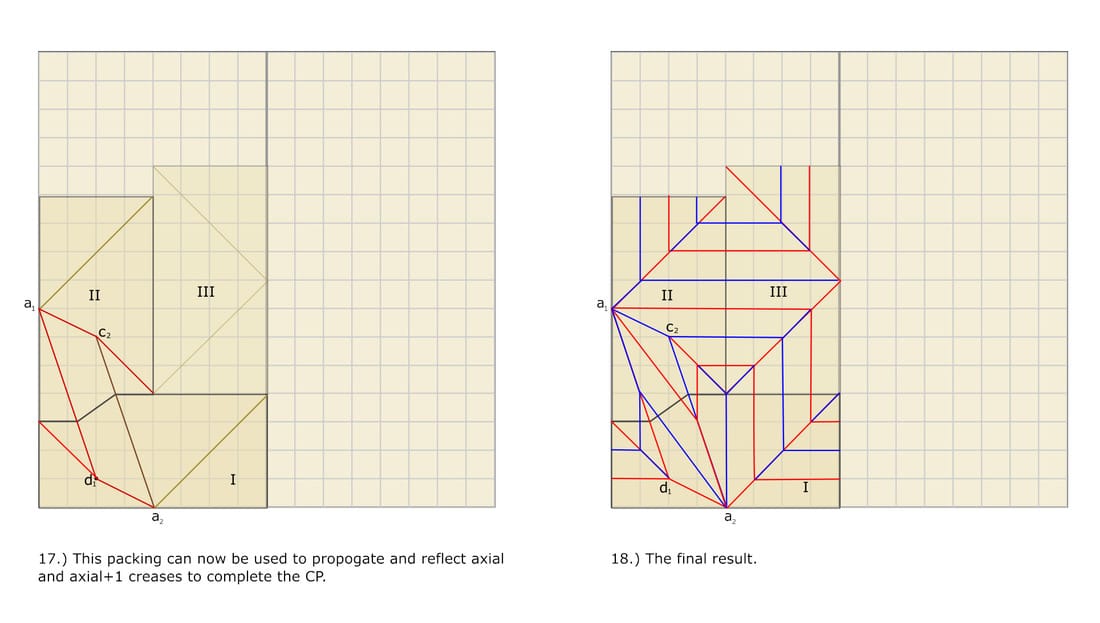They soon became good friends and together they generalized the notion of Pythagorean Stretch into GOPS and it was published in 7OSME. The Pythagorean stretch or Kamiyas pattern as it is also known was developed by Satoshi Kamiya.
The face takes a long time to collapse.

Origami pythagorean stretch. This has 8 faces 4 exterior 4 interior 8 vertices and 16 edges. Using a few tricks in designing Box-Pleating crease patterns such as Pythagorean stretches allows very efficient arrangements of flaps keeping the design foldable unlike most circle-packed designs. Stretch by a factor of 2 in the vertical direction so its sides become 2×1 unit rectangles.
Tsai lives in Taiwan and makes a living by doing full-stack developing. The Photographed model was folded from a 37 cm square of Grey O-gami. I need to choose five workshops to attend at the 5OSME Origami Science Math Education Conference in Singapore on Wednesday July 14 and Thursday July 15.
This page focuses on the process I came up with to create offset Pythagorean stretches and complete the challenge presented by Robert Lang in the second edition of Origami. Pythagorean theorem Figure 1c as total actual 2 total dL dL2 2 where L is the film length prior to stretching. Posted on July 1 2010 by prcloth.
The teeth are probably the most difficult part. Start the details of the face next. I classify this model as super-complex because of its unique and lengthy folding sequence and usage of closed sinks unsinks and even Pythagorean Stretches.
16 pages and 196 steps for my African Elephant which I designed this year in 2015. And indeed after reading the new chapter dedicated to polygon packing Tsai came up with a system to further generalized Pythagorean stretches. And I often found them more enjoyable to fold than pure box-pleating which is usually quite inefficient.
Finally we came up with exactly 16 pages including references with absolutely no spaces left. Very useful technique which will definitely come in handy in my future designs. There are a few ways but this video will show the easiest way which involves a b.
In Chapter 14 of the second edition of Robert Langs Origami Design Secrets Lang introduces the concept of a Pythagorean Stretch a system of creases that can be constructed between overlapping polygons in a box pleated crease pattern to increase efficiency for some examples see the crease patterns for Langs Camel Spider and Longhorn Beetle. Origami Design Generalized Offset Pythagorean Stretches in Box-Pleated Uniaxial Bases 591 Robert J. Theres also an input for the width.
So if for some reason we do not want to move the Pythagorean stretch element downward then we have to rearrange ridge creases of the upper-left polygon and the Pythagorean stretch element since they cannot intersect one another. Herein we use the actual displacement of the film total actual for the film d stretching tests and to discuss the stretching properties. During several rounds of corresponding together they polished the system into now known as GOPS and they wrote a.
The darkened section is used for the hair and should be brown on the actual paper while the rest of the colored side should be the colour of Chihiros bathouse outfit. So we will assume that the Pythagorean stretch element will stay where it is now and the circle would be the one that will be moved. A comprehensive learning site for k-higher 2.
Our GOPS example is on the upper right. You can add rivers like you would draw a line in Paint. Lang and Musun-T Tsai Orthogonal Voronoi Molecules 607 Robbyaft Kr Connected Paper Cranes by using Cntinued Fractionso ad Progressionsn 623 Jun Maekawa Efficient Origami Construction of Orthogonal Terrains using Cross 631 Section Evolution.
The pythagorean stretch should also be collapsed during this part. I used pythagorean stretches for the first time in my designs. You can move the circles inside the polygon useless for the moment will serve for CP generation you can also increase its size by clicking it or decrease its size by clicking while holding the shift key.
He particularly specializes in C and TypeScript. The development of Box Pleating Studio. Even though Kymiya is better known in the origami community as an author of very complex and ultra-realistic origami models his greatest achievement by far is a.
We demonstrate that parylene-C produces a flexible film that is highly stretchable. It may help to bring the other features of the model together by wrapping floral wire around them so that the pleats running in to the face are closer together. Used by over 10 million students.
Ad Parents worldwide trust IXL to help their kids reach their academic potential. How exactly do we construct pythagorean stretches for our crease patterns. It is titled Generalized Offset Pythagorean Stretches in Box-Pleated Uniaxial Bases and it was published in Origami 7 volume 2 pp.
Mu-Tsun Tsai began his studying of origami design theory by reading Robert J. My goal at the conference is to develop creative lesson plan ideas integrating Origami for my Geometry classes in Boston.
